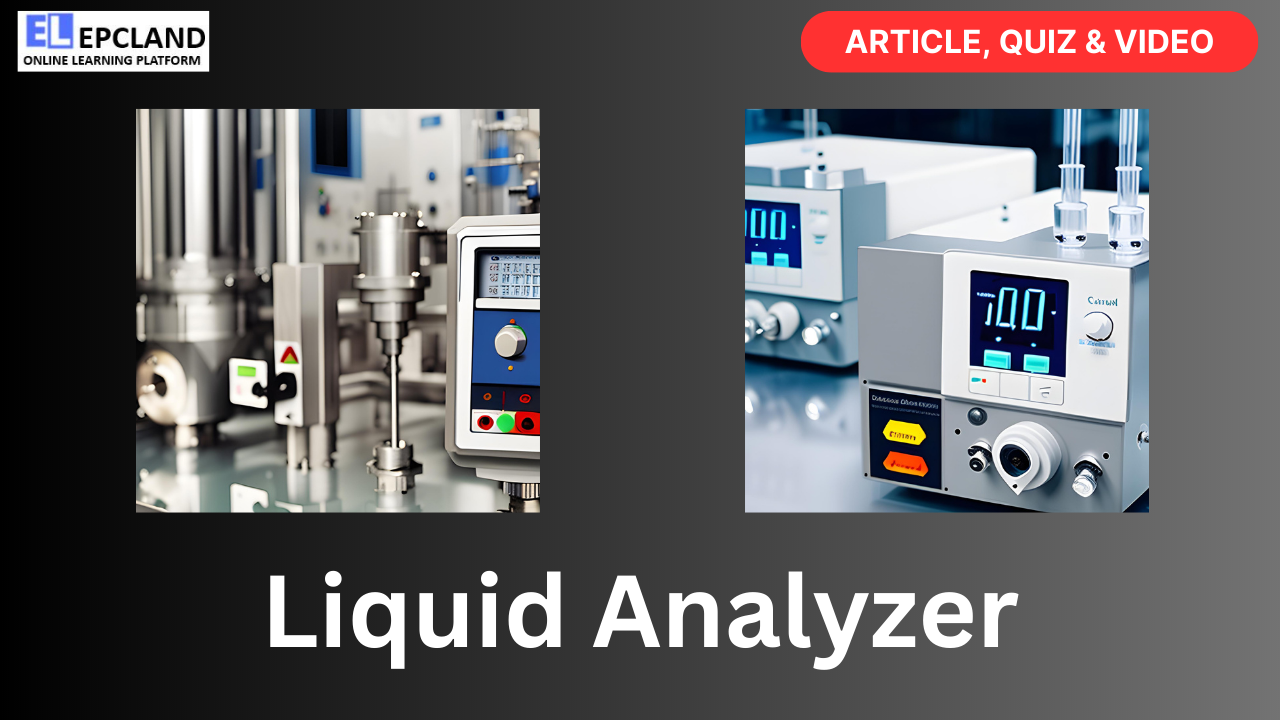The Oil and Gas Industry operates in one of the most demanding environments, where precision, safety, and efficiency are paramount. To meet these challenges, the industry relies heavily on advanced technologies, and one such critical tool is liquid analyzers. These devices are instrumental in monitoring, analyzing, and controlling the properties of liquids used in various processes within the Oil and Gas sector. In this comprehensive guide, we will delve into the world of liquid analyzers, exploring their importance, types, working principles, applications, and the role they play in enhancing project outcomes.
Table of Contents
Do not miss the Complete Course on Piping Engineering
By EPCLand
Understanding Liquid Analyzers
What Are Liquid Analyzers?
Liquid analyzers, as the name suggests, are instruments designed to analyze the physical and chemical properties of liquids. They are an indispensable part of the Oil and Gas Industry, where accurate and real-time data about the composition, quality, and characteristics of liquids is crucial for optimizing operations and ensuring safety.
Importance of Liquid Analysis in Oil and Gas
The Oil and Gas Industry involves a wide range of processes, from exploration and drilling to refining and transportation. In each of these processes, liquids play a vital role, and their properties can vary significantly. Liquid analyzers provide essential information for:
- Quality Control: Ensuring the quality of raw materials and products is a key concern in the industry. Liquid analyzers help detect impurities, contaminants, and deviations from desired specifications.
- Safety: Monitoring parameters such as toxicity, acidity, and flammability is critical for preventing accidents and ensuring the safety of personnel and equipment.
- Efficiency: Precise measurements of variables like flow rates, composition, and temperature allow for efficient process control and optimization, reducing energy consumption and waste.
Types of Liquid Analyzers
Liquid analyzers come in a variety of types, each designed to analyze specific properties of liquids. The choice of analyzer depends on the application and the properties being measured. Some common types include:
1. pH Analyzers
- Working Principle: pH analyzers measure the acidity or alkalinity of a liquid by measuring the concentration of hydrogen ions (H+) in the solution. This is done using a pH-sensitive electrode that generates a voltage proportional to the pH level.
2. Conductivity Analyzers
- Working Principle: Conductivity analyzers measure the ability of a liquid to conduct an electrical current. This is achieved by applying a voltage across two electrodes immersed in the liquid. The current passing between the electrodes is directly related to the liquid’s ion concentration.
3. Turbidity Analyzers
- Working Principle: Turbidity analyzers assess the cloudiness or haziness of a liquid caused by large numbers of individual particles that are generally invisible to the naked eye. They use a light source and a photodetector to measure the scattering of light by particles in the liquid.
4. Density Analyzers
- Working Principle: Density analyzers measure the mass of a liquid per unit volume. Common methods include vibrating tube sensors or buoyancy-based measurements.
5. Viscosity Analyzers
- Working Principle: Viscosity analyzers determine the thickness or stickiness of a liquid by measuring the resistance of the liquid to flow. This is often done using a rotating spindle immersed in the liquid.
6. Gas Chromatographs
- Working Principle: Gas chromatographs are used to separate and analyze the components of a liquid or gas mixture. They rely on the differential partitioning of analytes between a stationary phase and a mobile phase.
7. Spectrophotometers
- Working Principle: Spectrophotometers analyze the absorption of light by a liquid, providing information about its chemical composition. They work by passing a beam of light through the liquid and measuring the intensity of light absorbed at various wavelengths.
8. Moisture Analyzers
- Working Principle: Moisture analyzers, also known as moisture meters, measure the moisture content in a liquid. They typically use methods such as loss on drying or infrared moisture analysis.
9. Oxygen Analyzers
- Working Principle: Oxygen analyzers measure the concentration of oxygen in a liquid using electrochemical sensors or optical sensors that react with oxygen molecules.
10. Particle Counters
- Working Principle: Particle counters detect and count particles in a liquid, such as contaminants or wear particles in lubricating oil. They use methods like light obscuration or laser-based techniques.
Applications of Liquid Analyzers in the Oil and Gas Industry
Liquid analyzers find a wide range of applications in the Oil and Gas Industry. Here are some key areas where these instruments are deployed:
1. Oil Refining
In oil refineries, liquid analyzers are used to monitor and control various processes, including distillation, catalytic cracking, and hydrotreating. pH analyzers, conductivity analyzers, and density analyzers are crucial for ensuring the quality of refined products.
2. Natural Gas Processing
Liquid analyzers are employed in natural gas processing plants to measure the water content in natural gas streams. Moisture analyzers and spectrophotometers are used to ensure the gas meets pipeline specifications.
3. Pipeline Transportation
Maintaining the integrity of pipelines is essential for the safe and efficient transportation of oil and gas. Liquid analyzers, including density analyzers and viscosity analyzers, help detect anomalies in the transported fluids and prevent leaks or ruptures.
4. Water and Wastewater Treatment
The Oil and Gas Industry generates large volumes of wastewater that must be treated before disposal. pH analyzers, conductivity analyzers, and turbidity analyzers play a vital role in ensuring the effectiveness of wastewater treatment processes.
5. Safety Systems
Liquid analyzers are integrated into safety systems to detect hazardous conditions, such as leaks or spills of toxic or flammable liquids. These analyzers trigger alarms and emergency shutdowns to mitigate potential risks.
6. Well Monitoring
In drilling and well operations, liquid analyzers are used to monitor drilling mud properties, ensuring they meet drilling requirements. This helps prevent well blowouts and improves drilling efficiency.
Key Benefits of Liquid Analyzers in the Oil and Gas Industry
The use of liquid analyzers in the Oil and Gas Industry offers several significant benefits:
Do not miss the Complete Course on Piping Engineering
By EPCLand
| Advantages | Disadvantages |
|---|---|
| Improved Safety | Harsh Environments |
| Enhanced Quality Control | Calibration and Maintenance |
| Increased Efficiency | Data Integration |
| Reduced Downtime | Cybersecurity |
| Compliance with Regulations | Cost of Implementation |
| Cost Savings |
1. Improved Safety
Liquid analyzers play a crucial role in safety systems, detecting potential hazards and enabling rapid responses to prevent accidents and protect personnel and equipment.
2. Enhanced Quality Control
These analyzers help maintain the quality of raw materials and products, ensuring that they meet industry standards and customer specifications.
3. Increased Efficiency
Accurate measurement and control of liquid properties optimize processes, reduce energy consumption, minimize waste, and enhance overall operational efficiency.
4. Reduced Downtime
The ability to monitor equipment condition in real-time using liquid analyzers allows for predictive maintenance, reducing unplanned downtime and costly repairs.
5. Compliance with Regulations
Liquid analyzers assist in meeting regulatory requirements for environmental protection, safety, and product quality.
6. Cost Savings
By optimizing processes and minimizing waste, liquid analyzers contribute to cost savings in the Oil and Gas Industry.
Challenges in Using Liquid Analyzers
While liquid analyzers offer numerous benefits, their effective use in the Oil and Gas Industry comes with challenges:
1. Harsh Environments
Oil and gas facilities often operate in harsh and remote environments, which can subject liquid analyzers to extreme temperatures, corrosive chemicals, and mechanical stresses. Ensuring the reliability of analyzers in such conditions is a challenge.
2. Calibration and Maintenance
Regular calibration and maintenance are essential for the accuracy and reliability of liquid analyzers. In remote locations, accessing and servicing these instruments can be challenging.
3. Data Integration
Integrating data from multiple liquid analyzers into a centralized control system can be complex. Compatibility issues and data management can pose challenges.
4. Cybersecurity
As analyzers become more connected, they are susceptible to cybersecurity threats. Protecting these instruments from cyberattacks is a growing concern.
5. Cost of Implementation
The initial cost of purchasing and installing liquid analyzers can be substantial. However, the long-term benefits often outweigh the upfront investment.
Future Trends in Liquid Analysis for Oil and Gas
As technology continues to advance, the field of liquid analysis in the Oil and Gas Industry is evolving. Here are some future trends to watch:
1. Miniaturization and Portability
Advancements in sensor technology are leading to smaller and more portable liquid analyzers, making them suitable for use in remote and challenging environments.
2. IoT Integration
Liquid analyzers are increasingly being integrated into the Internet of Things (IoT) ecosystem, enabling real-time monitoring and remote control from centralized systems.
3. Advanced Materials
Materials used in liquid analyzers are evolving to withstand extreme conditions, improving the reliability and lifespan of these instruments.
4. Data Analytics and AI
Data generated by liquid analyzers can be harnessed for predictive maintenance, process optimization, and anomaly detection through artificial intelligence and data analytics.
5. Green Technologies
The industry is exploring eco-friendly liquid analyzers that minimize the use of hazardous chemicals and reduce environmental impact.
Conclusion
Liquid analyzers are the unsung heroes of the Oil and Gas Industry, providing crucial data that drives decision-making, ensures safety, and optimizes processes. From refining to transportation and safety systems, these instruments play a pivotal role in every facet of the industry. As technology continues to advance and industry demands grow, liquid analyzers will continue to evolve, contributing to safer, more efficient, and more sustainable Oil and Gas projects.
In this guide, we’ve explored the importance of liquid analyzers, their types, working principles, applications, benefits, challenges, and future trends. Understanding the role of liquid analyzers is essential for professionals in the Oil and Gas Industry, as these instruments are key to overcoming the industry’s unique challenges and achieving operational excellence.
Do not miss the Complete Course on Piping Engineering
By EPCLand
FAQs
1. What are the key parameters that liquid analyzers measure in the Oil and Gas Industry?
- Liquid analyzers in the Oil and Gas Industry measure a wide range of parameters, including pH levels, conductivity, turbidity, density, viscosity, gas composition, moisture content, and particle counts. These measurements are crucial for quality control, safety, and process optimization.
2. How do liquid analyzers contribute to safety in the Oil and Gas Industry?
- Liquid analyzers play a vital role in safety systems by detecting hazardous conditions such as leaks of toxic or flammable liquids. When abnormal conditions are detected, these analyzers trigger alarms and emergency shutdowns, preventing accidents and protecting personnel and equipment.
3. Can liquid analyzers be used in remote or harsh environments, such as offshore oil platforms?
- Yes, many liquid analyzers are designed to operate in remote and harsh environments commonly found in the Oil and Gas Industry. They are built to withstand extreme temperatures, corrosive chemicals, and mechanical stresses, making them suitable for offshore platforms, refineries, and other challenging settings.
4. How can liquid analyzers contribute to cost savings in the Oil and Gas Industry?
- Liquid analyzers contribute to cost savings by optimizing processes, reducing energy consumption, minimizing waste, and enabling predictive maintenance. These factors collectively lead to improved operational efficiency and reduced operational expenses.
5. What are the emerging trends in liquid analysis technology for the Oil and Gas Industry?
- Emerging trends in liquid analysis include miniaturization and portability of analyzers, integration with the Internet of Things (IoT) for real-time monitoring, the use of advanced materials to enhance durability, the application of data analytics and artificial intelligence for predictive maintenance, and the development of green technologies that reduce environmental impact.
Recommended courses (Published on EPCLand)
- Basics of Piping Engineering
- Piping Layout Engineering
- Piping Material Engineering
- Piping Stress Analysis
- Complete Course on Piping Engineering
- Material Requisitions
- Piping Material Specifications
- Valve Material Specifications
Don’t miss the published articles on following:
Related Video
Attempt Quiz
Question 1:
What is the primary function of a liquid analyzer in oil & gas projects?
Explanation: Liquid analyzers in oil & gas projects are primarily used to analyze the chemical composition of liquids, such as crude oil or natural gas condensate.
Question 2:
Which parameter can a liquid analyzer measure?
Explanation: Liquid analyzers can measure parameters like pH level to assess the acidity or alkalinity of the liquid being analyzed.
Question 3:
What type of liquid analyzer is commonly used for real-time monitoring of oil pipelines?
Explanation: NIR spectrophotometers are commonly used for real-time monitoring of oil pipelines to analyze the composition of flowing liquids.
Question 4:
What is the purpose of using a liquid analyzer in gas processing plants?
Explanation: Liquid analyzers in gas processing plants are used to ensure product quality and safety by monitoring the composition of liquids in the process.
Question 5:
What is the common technology used in liquid analyzers for measuring the concentration of specific chemicals in oil & gas applications?
Explanation: Infrared spectroscopy is a common technology used in liquid analyzers for measuring the concentration of specific chemicals in oil & gas applications.



